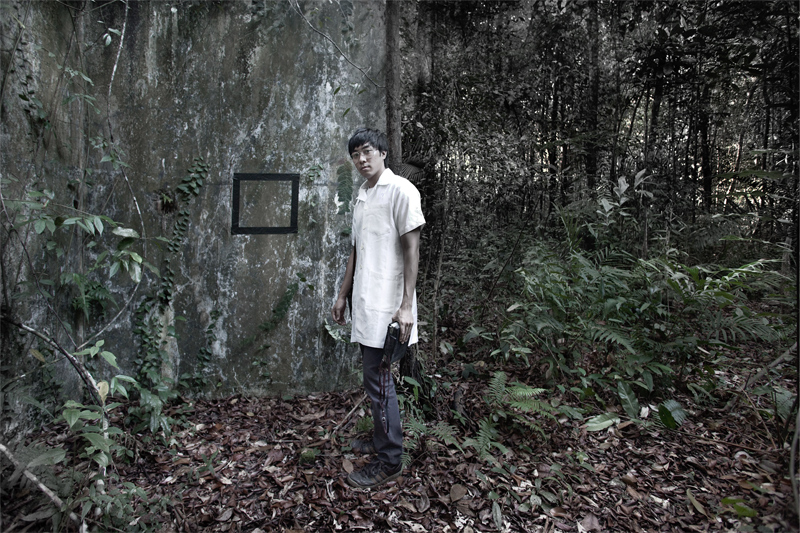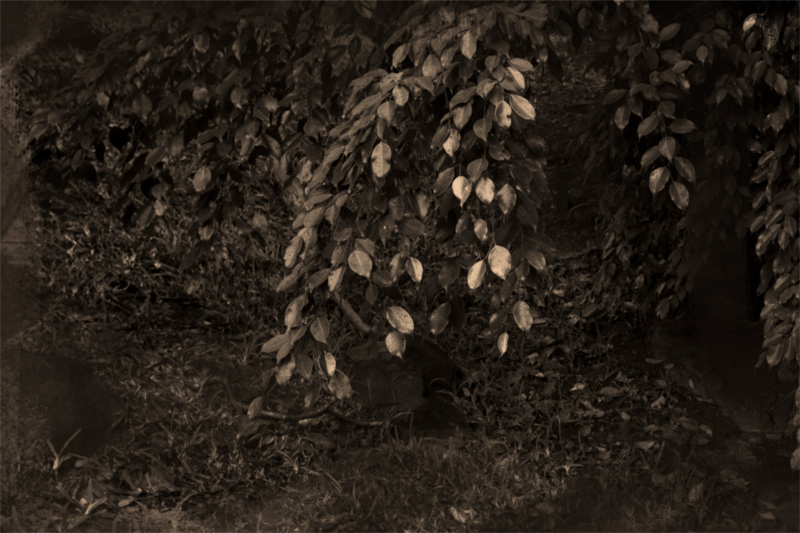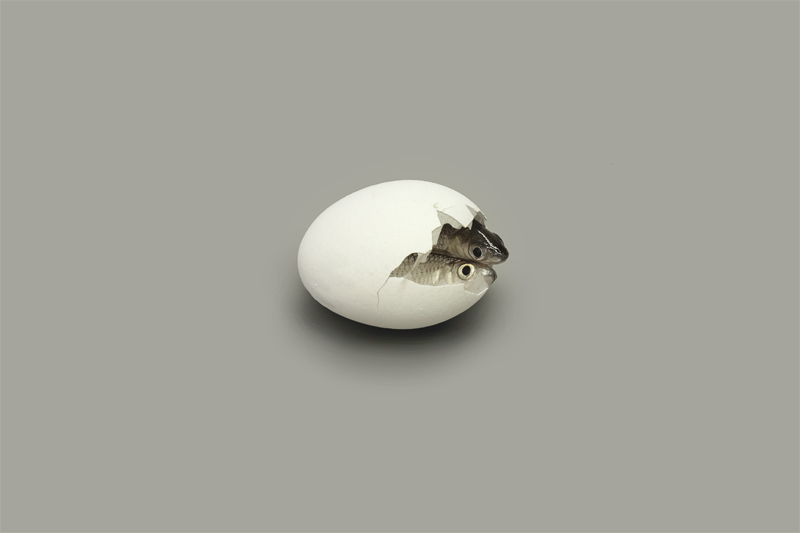All images by the ICZ
The Last thing you see
Kenneth Tay in conversation with Robert Zhao Renhui
KENNETH (KT): Shall I start off with a brief snapshot of you? And you can respond any way you like. I rather like this idea of us going back and forth through each other’s responses, being free to correct, edit, interject, and therefore in some ways already writing over one another. Perhaps what we'll end up with is something of an “exquisite corpse”: a photograph of Robert Zhao.
Despite having been trained as a photographer, in many of your installations you've obviously gone beyond the use of the photographic medium alone. But while it might be easy to brand you as yet another multi-disciplinary artist, I think much – if not all – of your work still comes back to photography itself. Or to be more precise: the idea of photography in its various framings and implications. But in particular, photography's position within the Enlightenment discourse of light and the transparency of reason. Today, of course, photographs are still being used as legal evidence in courts, or as accompaniments to scientific research; they have in that sense a kind of objective currency not all that different from money. Yet, the capacity of the camera to see now far exceeds the limits of our own (embodied) sight. Is photography for you, then, a site from which one could go on to question our existing frames of reference?
ROBERT ZHAO (ZRH): I have always been interested in photography and the way a photograph talks to us. A lot of my work is informed by the way photography behaves. My installations are an image of a situation. My books are photographs of other books and my documents are images of other documents.
Even my interest with animal traps is linked to my interest with photography. A photograph can trap us rather than liberate us. Seeing can be dangerous and misleading because we always have an eye out for the truth. It narrows our vision and the price to pay is not really knowing the bigger picture. That's how animals get trapped – they fail to see beyond what is already presented to them.
My tutor in college once commented on how naive we are when we read photographs. We are not as familiar with reading photographs as we are with text. We also rely on photographs too much for reassurance.
If we flip through the newspapers today, most of the images are unnecessary. They do not really say more than what the text is already telling us. I think our experience with images will only get more complex. Tons of useless images are being created everyday and we know it. That's fine. Everybody knows that Instagram is rubbish and images are getting less reliable. So what can we believe in now?
 Lead wall, Masayuji Yanai, Guiana Highlands Plateau, Brazil, 2006.
Lead wall, Masayuji Yanai, Guiana Highlands Plateau, Brazil, 2006.
KT:
Yes, unfortunately the visual literacy demanded by the texture of photographs seems to be, for the most part, taken for granted. Perhaps it is productive for us to come to what the term "photography" translates to: light-writing. For me, it describes not only a process where one writes with light, but also how light, and its attendant notions of truth and authenticity, is projected through photographs. In short, how photographs produce the standards for what is authentic, and so on. In a strange overturn, we might even say that reality is no longer the cause or origin of the photograph. Rather, it is the effect. (Could we not also say that it has always been the case?) And if the camera can see faster and sharper than the human eye today, wouldn’t this also suggest that the basis of what is real no longer resides within the body of the human? We ourselves no longer function as the markers for what is real.

Figure 1. A Living Leaf - ‘As the wind travels through the foliage, the leaves move to their own life.’
Japanese daguerreotype, 1861. An Ancient Leaf Insect. Masahiro Koishikawa, this article proposes that a Japanese daguerreotype (an old photograph) from 1861 depicts a leaf insect.
ZRH :
Determining what is real is tough. I prefer instability and slippages. I collect a lot of photographs, and I am especially attracted to photographs that appear to be lost and uncertain, and photographs that say very little. It can be liberating to give some form of certainty to these lost images. Sometimes it may be a good thing that a photograph loses its studium and can float free in the world.
A photograph on its own is utterly silent and we always try to lend it a voice. We also have a tendency to give voices to things that otherwise will not speak for themselves. Some activist groups base their origins and activities around photographs of seemingly voiceless creatures that need a voice. A long time ago, I was a photographer working for an animal activist group and I was aware of the way images were manipulated and mobilised for certain agendas.
KT:
I would like to dwell on what you've mentioned as your past experience working with animal activist groups. Looking through the body of works you have made so far, clearly the question of the zoological remains a perennial concern for you. Indeed, it seems almost logical when we consider the long and intimate relationship photography has had with hunting: many developments in photographic technology have come about in trying to capture the almost imperceptible movements of animals; paparazzi photographers stalk celebrities as hunters would for game; and even the term "snapshot" is a derivative gesture of hunting. Yet, while some critics seem happy to describe your work as a critique of the zoological gaze enabled by photography (i.e. the ability to classify, catalogue, and command animals; and thereby reaffirming Man's position as the rational centre of the universe), there is also something rather playful in many of your images. For the most part, they tend to occupy that space between what looks like straight documentation and what looks discernibly staged. Even the subjects photographed constantly oscillate between fact and fiction, not unlike Borges's famous bestiary. Do you think you could elaborate on this propensity towards suspension in your images?
 Fish in eggs, Matsura. A
Fish in eggs, Matsura. A
ZRH:
The latest ‘Frozen Planet’ documentary series on BBC showed a 30-second shot of two newborn polar
bear cubs that were filmed in the zoo. But the footage was spliced with other footage shot in the Arctic — it seemed as though the producers were trying to pass off these captive baby bears as wild ones. In any case, I didn’t really care. But some viewers felt they were misled and went on to look for other moments where Sir David Attenborough “lied” in his documentaries. Television audiences seem to have a secret longing for wildlife filmmakers to get up close with the polar bears, and even better, to risk their lives to get as close as possible. It is useful to remember that any animal on show, in the media or in photographs, is always giving a performance. Wildlife documentaries and circuses constantly show animals in varying states of performance.
The idea of a performance is important in my work. A useful way of thinking about my pictures is that they are photographs of photographs. Most of the images I create are representations of images that I have seen from other places. So on this one level, they are already removed from the “real”. They are performing as documents and so-called truthful images.
Mixed into this are images and information that are completely fictitious. I’m still trying to understand why I do this. My girlfriend thinks I like lying because I have control issues. Sometimes critics say that I am providing interruptions to the performance, to show the thin line between imagination and so-called truths, to show the constructed nature of it all. But I think, ultimately this is why I use fiction: photography as a medium, as a whole, is fiction to me. It’s not real, but others seem to associate it with truth. I’m more concerned with how we grapple and make sense of what is presented to us. This includes the text and the conditions in which the viewing takes place. It is after all in an art gallery so I’m definitely not trying to present science to you. I find it strange that people would not ask the same questions about a painting that references photographs.
I have a website which is a performance platform for some of my images. Sometimes parts of my projects are created specifically for this website. I meant for the images to exist online. I am curious to find out what time will do to these images.
KT :
As others like the philosopher Jacques Derrida have pointed out, philosophy and photography share a secret rapport. In an early essay entitled "Force and Signification", Derrida goes as far as to propose that the entire history of philosophy is a "photology". That is to say, philosophy has been a long ongoing treatise on light as the condition of possibility for clarification, reflection, illumination, and even speculation. We live, therefore, in a photosensitive culture. The camera, as the ubiquitous technology of our time, now literally frames our world; it illustrates for us the settings expected for truth to emerge.
But even as photography finds itself swept under this current of photology, I think in many ways photography also continues to destabilise it, not just in the manner you have described of your own practice. For if such notions of light were truly self-evident truths in themselves, they would not require photography to play the role of a supporting actor. To paraphrase Derrida here, photography functions as a troubling supplement.
So when you mentioned that your photographs are very much photographs of photographs, I can't help but come back to this idea of the supplement in the form of the frame. By framing photographs this way (or perhaps more precisely – the rhetoric of the image), your work at once puts the entire edifice into view. For me your work actually supports it, compliments it through reproduction. But at the same time, like the text that so often accompany your images so as to frame them in a certain viewing context, it also reveals, precisely, this inherent lack in the image. There is then always this need to supplement, to compensate, to frame; a playful mix of compliment and complement that is constantly present in your photographs.
ZRH:
Interesting observation. While my works often remind people of the instability of photography, often by “quoting” certain conventions — scientific documents, photojournalism, wildlife photography etc. — or you can call them framing devices, I’ve been trying a new direction with my latest work: by economising on the narratives around my work. To let them be, in a way, more direct. Sans intervention.
Michel Foucault said that “visibility is a trap”. He meant it in the case of the Panopticon, a prison where the all the inmates were visible to one another, hence creating a system of totalitarian, mutual surveillance. I’ve been thinking a lot about this statement, but with the trap not relating to the observed, but the observer. Visibility is a trap because we imagine we know a lot through empirical evidence. But what is beyond the visible?
“The Last Thing You See” is an attempt to tackle this question. For the longest time, nobody knew why certain spiders weave distinctive markings on their webs. It isn’t logical for spiders to make these markings because then they render an otherwise hard-to-see web visible. Scientists came up with a theory that the markings are made to warn larger animals to not walk into the spider web and destroy it. In other words, the insect trap had a defense mechanism.
It was not only recently that we realised that most insects see in the UV spectrum, a visual spectrum invisible to humans. Under UV light, the web mimics the shape of a flower. These markings are also visible on flowers in UV light. A spider web that wants to be a flower. I like that idea. A mimic and an invisible trap. Like a photo.
KT:
In that sense, could we then speak of a blindness in photography? Or for the matter, perhaps a kind of “blind photography” at work in your photographs? But I don’t mean that simply to say that your works question the blind-spots in our thinking about photography. Rather, that is for me at least, the term “blind photography” also suggests that photography itself involves a certain element of faith or trust just as a blind person would rely on either his/her other senses, or in some cases: a guide dog. Which is to say, no single photograph is ever complete or independent onto itself; it always relies on others. Its value, therefore, is never intrinsic or inherent in itself, but always extrinsic and relational. Such as it is, every photograph might be said to be a “negative” - even if this seems to run counter to our experience with digital photography today.
I think this metaphor of blindness is interesting since it pushes us to think beyond what is depicted, to think beyond a literal reading of a photograph – something that your photographs constantly push us towards when we are forced to grab onto whatever we know, read, or see in order to make sense of the image before us. Yet, herein lies the irony of what I am saying: for I am trying to shed some light on your work, but only insofar as to claim that it privileges a certain blindness over our impulse to overexpose the various meanings of a photograph. I hadn’t seen that coming.
======
KENNETH TAY is an assistant curator at NUS Museum in charge of the Ng Eng Teng Collection. He is interested in the intersections between the histories and theories of photography and the moving image; not so much for what they each say about their respective medium, but in the ways they may be mobilised to engage with ways of seeing at large.
Copyright 2013, Institute of Critical Zoologists